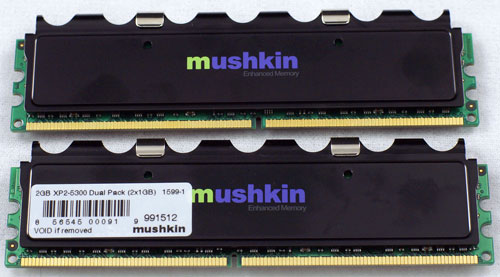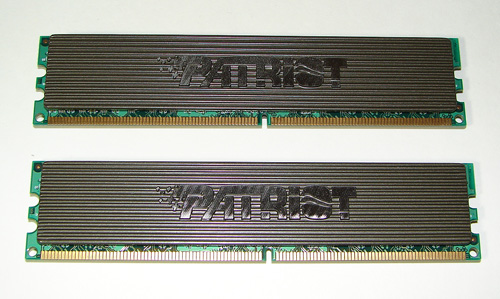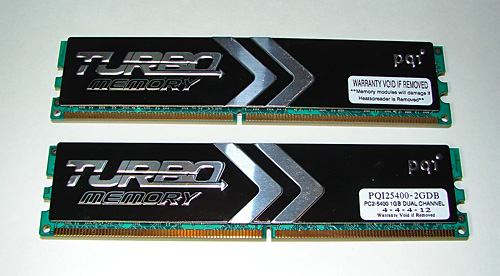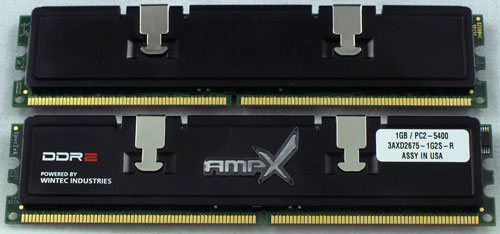Conroe Buying Guide: Feeding the Monster
by Gary Key & Wesley Fink on July 19, 2006 6:20 AM EST- Posted in
- Motherboards
Mushkin eXtreme DDR2-667

The Mushkin DDR2-667 memory arrived with the highest price in our value roundup, an excellent heat spreader design, but performed below average at the DDR2-667 and DDR2-800 settings. We raised the voltages but did not have any success in improving the timings at these settings. However, the Mushkin ran at stock voltages for the low latency DDR2-400 and DDR2-533 settings although the 3-3-3-8 timings at DDR2-533 could not be improved with additional voltage to match the 3-2-2-7 timings of other modules. Also, this is the only memory in our group that would not run 4-3-3 settings at DDR2-800. Although the performance difference is minimal, the cost of this kit indicates the memory should perform better.
Patriot DDR2-667

Patriot Memory provided their Extreme Performance series memory modules that provided above average performance at voltage settings that were more than acceptable for 24/7 operation. The memory comes with stylish heat spreaders and was able to easily clock up to DDR2-900 at extended voltages and 5-5-5-15 timings, though we recommend the lower latencies at DDR2-800.
PQI Turbo DDR2-667

The bargain of the bunch has to be the PQI Turbo kit that is currently selling for around $117 with rebate. While the timing performance of the memory was excellent we had to run at voltages higher than the group's average to meet these settings. The base voltage for this particular model is 2.0V, something to be aware of based upon our results with the other memory modules.
Wintec AMPX DDR2-667

The Wintec AMPX DDR2 Extreme series of memory was the pleasant surprise of the group as it generated excellent timings at low voltages at the lower memory speeds. It performed average at DDR2-800, although the results are more than acceptable.
Comparing Value Memory
All of the memory in the value section was able to run on average 4-3-3-9 settings at DDR2-800 except for the Mushkin modules that were limited to 4-4-4-12 but at a low 2.0V setting. The performance delta is extremely minor and the lower voltages are welcomed, but the Mushkin memory is the most expensive in our group so we naturally expect more from it.
The ability of all our value memory to run at very low latencies at DDR2-667 and 4-3-3-9 latencies at DDR2-800 is just incredible given the average price of $148 for a 2GB kit. Not even a year ago this type of performance in the DDR2 world would have placed this "value" memory at the top of performance charts. We found the Elpida memory to offer higher overclocks at lower memory voltages overall than the Infineon based modules, making it the current leader in value performance memory in our opinion.
The two modules that stood out were the A-Data Vitesta DDR2-533 and Wintec AMPX DDR2-667. During testing, both offered a unique combination of price, performance, and stability. All of the memory reviewed is more than acceptable for a Conroe system and the performance differences are so minor that we suggest choosing a supplier based upon prior experience, warranty, or price in this case. We will be looking at additional value memory modules from other suppliers shortly along with providing performance test results with our new Core 2 Duo Memory test platform.

The Mushkin DDR2-667 memory arrived with the highest price in our value roundup, an excellent heat spreader design, but performed below average at the DDR2-667 and DDR2-800 settings. We raised the voltages but did not have any success in improving the timings at these settings. However, the Mushkin ran at stock voltages for the low latency DDR2-400 and DDR2-533 settings although the 3-3-3-8 timings at DDR2-533 could not be improved with additional voltage to match the 3-2-2-7 timings of other modules. Also, this is the only memory in our group that would not run 4-3-3 settings at DDR2-800. Although the performance difference is minimal, the cost of this kit indicates the memory should perform better.
| Mushkin - DDR2-667 - 2x1GB Model # 991512 |
||
| CPU Ratio | Memory Speed |
Best Memory Timings (Voltage) |
| (4:3) | 400 DDR2 | 3-2-2-5 1.8V |
| (1:1) | 533 DDR2 | 3-3-3-8 1.8V |
| (4:5) | 667 DDR2 | 3-3-3-10 2.1V |
| (2:3) | 800 DDR2 | 4-4-4-12 2.0V |
Patriot DDR2-667

Patriot Memory provided their Extreme Performance series memory modules that provided above average performance at voltage settings that were more than acceptable for 24/7 operation. The memory comes with stylish heat spreaders and was able to easily clock up to DDR2-900 at extended voltages and 5-5-5-15 timings, though we recommend the lower latencies at DDR2-800.
| Patriot - DDR2-667 - 2x1GB Model # PDC22G5300LLK |
||
| CPU Ratio | Memory Speed |
Best Memory Timings (Voltage) |
| (4:3) | 400 DDR2 | 3-2-2-5 1.9V |
| (1:1) | 533 DDR2 | 3-2-3-7 1.9V |
| (4:5) | 667 DDR2 | 3-3-3-8 2.1V |
| (2:3) | 800 DDR2 | 4-3-3-8 2.1V |
PQI Turbo DDR2-667

The bargain of the bunch has to be the PQI Turbo kit that is currently selling for around $117 with rebate. While the timing performance of the memory was excellent we had to run at voltages higher than the group's average to meet these settings. The base voltage for this particular model is 2.0V, something to be aware of based upon our results with the other memory modules.
| PQI - DDR2-667 - 2x1GB Model # PQI25400-2GDB |
||
| CPU Ratio | Memory Speed |
Best Memory Timings (Voltage) |
| (4:3) | 400 DDR2 | 3-2-2-5 2.0V |
| (1:1) | 533 DDR2 | 3-2-2-7 2.0V |
| (4:5) | 667 DDR2 | 3-2-3-9 2.2V |
| (2:3) | 800 DDR2 | 4-3-3-9 2.2V |
Wintec AMPX DDR2-667

The Wintec AMPX DDR2 Extreme series of memory was the pleasant surprise of the group as it generated excellent timings at low voltages at the lower memory speeds. It performed average at DDR2-800, although the results are more than acceptable.
| Wintec AMPX - DDR2-667 - 2x1GB Model # 3AXD2675-1G2S-R |
||
| CPU Ratio | Memory Speed |
Best Memory Timings (Voltage) |
| (4:3) | 400 DDR2 | 3-2-2-5 1.8V |
| (1:1) | 533 DDR2 | 3-2-2-7 1.9V |
| (4:5) | 667 DDR2 | 3-3-3-8 2.15V |
| (2:3) | 800 DDR2 | 4-3-3-9 2.2V |
Comparing Value Memory
All of the memory in the value section was able to run on average 4-3-3-9 settings at DDR2-800 except for the Mushkin modules that were limited to 4-4-4-12 but at a low 2.0V setting. The performance delta is extremely minor and the lower voltages are welcomed, but the Mushkin memory is the most expensive in our group so we naturally expect more from it.
The ability of all our value memory to run at very low latencies at DDR2-667 and 4-3-3-9 latencies at DDR2-800 is just incredible given the average price of $148 for a 2GB kit. Not even a year ago this type of performance in the DDR2 world would have placed this "value" memory at the top of performance charts. We found the Elpida memory to offer higher overclocks at lower memory voltages overall than the Infineon based modules, making it the current leader in value performance memory in our opinion.
The two modules that stood out were the A-Data Vitesta DDR2-533 and Wintec AMPX DDR2-667. During testing, both offered a unique combination of price, performance, and stability. All of the memory reviewed is more than acceptable for a Conroe system and the performance differences are so minor that we suggest choosing a supplier based upon prior experience, warranty, or price in this case. We will be looking at additional value memory modules from other suppliers shortly along with providing performance test results with our new Core 2 Duo Memory test platform.










123 Comments
View All Comments
Bochista - Thursday, July 20, 2006 - link
With the release of new Quad SLI beta drivers I would like to know what board is compatible with both the Conroe & Quad SLI. Being CPU bound in graphics I think it would very interesting to see. The ASUS P5N32-SLI SE is not on the Quad-SLI list. The Asus P5N32-SLI Deluxe is not either.Bo
Gary Key - Thursday, July 20, 2006 - link
It should be on the list shortly. This is the board that NVIDIA has been using to test and display Quad SLI on with Conroe. We also understand this board will probably make its way into several Quad SLI systems according to NVIDIA. It will be interesting to see how this board performs against the nF590 in a couple of weeks. ;-)
jonmcguffin - Thursday, July 20, 2006 - link
If Core 2 Duo is sucking up so much less energy, why have I not heard anything about the need to NOT buy the 500-650 watt power supplies. It would seem to me that a processor and mainboard that consumers so little power would not need anything more than a good 350 or 400 watt power supply, even in an SLI configuration.It would be nice to see something written up in your review that stated...
Hey, these processors are going to require X amount of power on the lower end and X amount on the higher end. Given power supplies are typically only 75-80% efficient and leaving another 10-15% left over in overhead, you should be using power supplies with a watt rating of X.
Jon
Gary Key - Thursday, July 20, 2006 - link
Jon,Anand went over the power requirements in the CPU review article. However, from a platform level the current 7900GTX and X1900XT cards in SLI or Crossfire will require a very good 500+ watt (on the edge with CrossFire) power supply with Conroe, AM2, or Netburst CPUs. In fact, we highly recommend and use 700+ watt machines in our systems to ensure proper power delivery when running SLI or CrossFire while overclocking. The power requirements of the next generation GPUs for SLI or CrossFire will require 700w power supplies and we generally will see 900+ watt supplies for those who expect to overclock both the CPU and GPU. While we have seen the CPUs reduce their power requirements over the last two years (except at the high end until Conroe, AM2 EE is great), the GPU requirements along with the platform chipsets (ATI RD580 is the exception currently) have sky rocketed. By the time you add a couple of large hard drives, optical drives, SLI or Crossfire, and a FX60 or 955XE, you are already limited by the typical 400~500 watt power supply. While Conroe will make a difference compared to most Netburst based CPUs and the upper end AM2 processor series, it is not enough to even think about dropping below 500w at this time. In my personal systems, the first item I budget for is a really good power supply, never skimp on proper rail voltages and quality, it is the basis for a trouble free system.
Hope this helps....
ninethirty - Friday, July 21, 2006 - link
Would you guys mind doing some tests to back that up in Part 2? Reading SilentPCReview.com, there's some pretty convincing arguments that the need for higher wattage is overblown. And 900W+ is hard to believe...pretty soon you'll be talking about dedicated wall sockets.I think most folks are talking about one video card, not SLI. I'd like to issue a challenge: try a test with the Core 2 Duo, a Geforce 7600GT like in the "Building a Better Budget PC" article, and a 300W Seasonic PSU (or any 80% efficient, true-to-ratings). Then, see how it effects overclocking. That PSU can run an AMD64 x2 3800+ and a 7900GT, why couldn't it run the Core 2 Duo with voltage to spare?
There, I've thrown in my gauntlet.
jonmcguffin - Thursday, July 20, 2006 - link
#1) Paul - My point in bringing up the Digital Thermal Sensor capability of the Core 2 Duo chip and it's "possible" support on the P965 was mainly just to show that there may in fact be certain features the P965 has that are superior to the 975X. Certainly not planning any extreme overclocking and a good HSF is certainly a priority, but still utilizing the Core 2 Duo chip to its fullest abilities is important to me and that means a motherboard that supports this Core 2 Duo feature. If P965 boards support this feature out of the box and the 975X boards don’t, it’s a factor that could play into my purchasing decision.#2) Thanks Gary & Wesley for the explanation on why you didn't include the AB9 Pro motherboard. That makes perfect sense. It seems to me this is the board to target but to be at this point in the game and NOT have a mature enough BIOS to manipulate RAM settings is a little concerning to me. This coupled with Abit's financial issue's in the past almost have me fearful of taking a chance on this board.
I hope in your roundup article you will provide some insight into all this business with 12-phase power and solid state capacitors. What does this mean to the over clocker or the serious workstation user?
Lastly.......
Slightly off-topic here but PERHAPS something you two could include in your more extensive roundup of the next Core 2 Duo motherboards or maybe in a separate article.
On-Board Audio……….
This may be old hat to many here, but this is an issue that I haven't seen addressed anywhere recently. On-Board audio solutions have "evidently" been creaping up on SB products for sometime now. A better explanation as to the feature benefits of some of these on-board solutions (RealTek 882D, 882, 883, 885, 888, ADI, etc) and how they are implemented would be helpful.
#1) Top of this list is the confusion regarding digital audio & HD Audio. Seems every mobo now includes either Optical or Coax digital out on their back plates. What does tihs mean to the gamer, the audio professional, audiophile, or just the everyday computer user who wants to hook up an external amp and some higher end speakers and listen to very high quality stereo music. What the heck is HD Audio and what does that mean? How does it apply to the various groups I mentioned above?
#2 – If I’m going to use the digital out on my board, what difference does it make what onboard or offboard sound solution I use. If the computer is spitting out bit-by-bit digital audio data, isn’t a RealTek ALC650 digital out everybit as good as a Creative Labs SoundBlaster X-Fi Platinum Edition?
#3 – What is the deal with all the new audio codec’s out and their supposed support for Dolby Digital. What does this mean to the consumer? I would imagine 90% of all computer users here and a similar vast majority elsewhere don’t use anything more than a simple 2.1 configuration or perhaps headphones. 7.1 or 7.2 sound is worthless. Does Dolby Digital provide any extra benefits to these 2.1 or headphone listeners? Does it play back my music from .MP3’s or iTunes sound any better?
#4 – What really is EAX and is there that big of a difference between EAX 3.0 – EAX 5.0? And again, how does this relate to digital audio. If some external source is doing the audio conversion, do these technologies even matter?
These may appear to be rather easy questions to answer, but the reality is that we’ve been bombarded so badly with marketing by Creative and others with audio that most of us really don’t know what the heck it is we’re buying.
Personally, the quality of audio output is really important to me. I mostly listen to music and occasionally will play a few games. One BIG question for me is do I save $125 and go with on-board “digital” audio or not.
Thanks!
Jon
Paladin165 - Thursday, July 20, 2006 - link
7.2 sound??ic144 - Thursday, July 20, 2006 - link
Just by looking at this article, you can see how much attention is on Intel's Core 2 Duo. I don't remember so much attention was invested for the AMD Athlon64 FXs when they were launched. LOL.Wesley Fink - Thursday, July 20, 2006 - link
We looked back at the launch review of A64 on Sept. 23, 2003. As you can see for yourself at http://www.anandtech.com/cpuchipsets/showdoc.aspx?...">http://www.anandtech.com/cpuchipsets/showdoc.aspx?... the AMD won Business Winstone and the Intel 3.2 won the MMC Winstone. Gaming results were split, with A64 winning most and the Intel 3.2 winning Quake 3. A64 led in Workstation development and Intel in Encoding. In other words, A64 won by a small margin. The AMD lead grew over time and our coverage continued to grow.We can't remember the last time a new CPU was laucnched that was 20% to 30% faster than the competition in everything we tested. There are really no weaknesses we have found in Core 2 Duo performance. This is a once in a decade event. AMD has responded with massive price cuts that position their new CPUs much more in line with Core 2 Duo based on performance, but they really don't have an answer to conroe, since almost every Conroe chip is faster than the fastest A64. We wish AMD did have a quick fix, since competition is good for buyers.
We are fans of performance at AT, and we have been very supportive of A64 as it took the performance lead and extended it over the past 2+ years. However, those who ignore the current Cnroe advantage are not looking at performance, they are speaking from emotion. Conroe performance can not be ignored or twisted with GPU-bound benchmarks to show show something that is simply not true. Things will likely shift again in the future - AMD has shown itself to be very resilient - and we will loudly proclaim AMD's lead if they regain the performance crown.
MadBoris - Thursday, July 20, 2006 - link
I owe Anandtech much, you guys have consistently provided excellent quality info for years.Thx for another great article, I'm looking forward to part two.
You guys have peaked my curiosity on the tuniq tower. I didn't see it reviewed here yet. Is it that much better than the competition, it's definitely beastly looking?